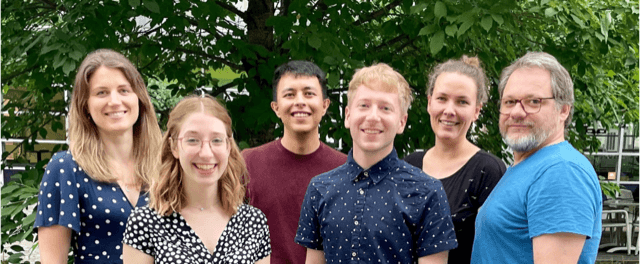UAS Technikum Wien Researches the Rejuvenation of Cells

18 December, 2023
The “AgingTissue” research project sheds light on how cells age and what can be done about it
For more than two decades, UAS Technikum Wien has been a leader in the development of artificial tissues and their application in regenerative medicine. The “AgingTissue” research competence team, funded by the City of Vienna (MA23), is currently working on an important step: the effects of the ageing process on tissue regeneration. Three researchers under the leadership of Gordin Zupkovitz are expanding in-house established 3D tissue regeneration models to include the decisive factor of ageing. They are investigating the effects of this process on various tissues and exploring strategies to mitigate its effects and develop potential anti-ageing products.
The ageing of muscle-like precursor cells leads to fewer muscle fibers
In the “AgingTissue” project, various cell types that are affected by ageing are being examined under the microscope. Research is currently being carried out into the extent to which new muscle fibers can be formed in aged cells. For this purpose, an established model for in vitro studies on muscle fiber formation was used. It was found that artificially aged myoblasts, muscle precursor cells of the mouse, completely lose the ability to form new muscle fibers. In addition, differentiation of a mixed population of non-aged and aged mouse myoblasts resulted in the formation of shorter and thinner muscle fibers compared to differentiation of a control containing only non-aged myoblasts. This suggests that the accumulation of aged cells has a negative effect on muscle formation and regeneration. “We can’t say for sure because mice and humans are different species, but these results could indicate that aged muscle progenitor cells also lead to the formation of fewer and fewer new muscle fibers in humans, which contributes to the loss of muscle mass and its functionality,” explains Gordin Zupkovitz. He is referring to age-related muscle atrophy, a disease that affects 13 percent of the population over the age of 65 and 50 percent of the population over the age of 85.
Scientists are now interested in how aged cells, which are often associated with age-related diseases, can be reactivated.
The focus of anti-ageing research at UAS Technikum Wien is the effect of shock wave treatment in combination with senolytic substances. These compounds are substances that selectively cause aged cells to die and thus potentially contribute to the general health of an organism.
It is planned to extend the existing research work to include the anti-ageing effect of food ingredients. There are a number of substances in the conventional diet that are thought to contribute to healthier ageing. For example, resveratrol, which is found in the skin of red fruits such as grapes, blueberries and raspberries, or curcumin, which gives turmeric its yellow color. The project team will investigate the presumed protective effect of these compounds on cells during the ageing process and their influence on the regenerative capacity of cells/tissues. These substances will then be tested as anti-ageing preparations in a specially developed 3D environment.
Last but not least, all the findings of the AgingTissue competence team will be incorporated into the teaching activities of the Department of Life Science Engineering, particularly in the “Biomedical Engineering” and “Tissue Engineering and Regenerative Medicine” degree programs, thus further underlining UAS Technikum Wien’s position as one of the leading Austrian institutions in the field of tissue engineering.

Anti-aging Research
The focus of anti-ageing research at UAS Technikum Wien is the effect of shock wave treatment in combination with senolytic substances. These compounds are substances that selectively cause aged cells to die and thus potentially contribute to the general health of an organism.
It is planned to extend the existing research work to include the anti-ageing effect of food ingredients. There are a number of substances in the conventional diet that are thought to contribute to healthier ageing. For example, resveratrol, which is found in the skin of red fruits such as grapes, blueberries and raspberries, or curcumin, which gives turmeric its yellow color. The project team will investigate the presumed protective effect of these compounds on cells during the ageing process and their influence on the regenerative capacity of cells/tissues. These substances will then be tested as anti-ageing preparations in a specially developed 3D environment.
Last but not least, all the findings of the AgingTissue competence team will be incorporated into the teaching activities of the Department of Life Science Engineering, in particular in the degree programs “Biomedical Engineering” and “Tissue Engineering and Regenerative Medicine”, thus further underlining the position of UAS Technikum Wien as one of the leading Austrian institutions in the field of tissue engineering.

From left to right: Dorota Szwarc, Michaela Kienberger, Ricardo Ausencio Chamacho Novoa, Sebastian Dörfler, Anna Weihs and Gordin Zupkovitz